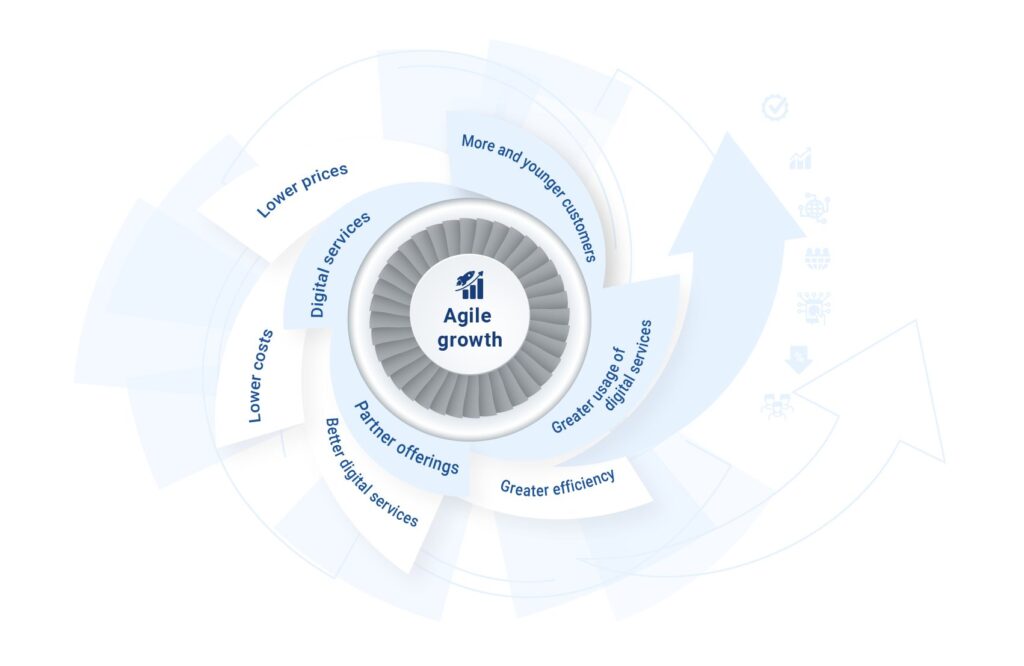
5G, bundling offers, personalization – CSPs have to keep developing constantly in order to achieve long-term success. But how can they succeed in keeping an eye on the overall goal with so much innovation and change in completely divergent areas of digital marketing and sales? Or perhaps the question should be “How can they even define a strategy for the digital transformation?”
An answer to this is the so-called flywheel concept, which Amazon uses, for example. The name borrows from the machine element “flywheel,” which – once set in motion – saves energy and transmits it without great frictional losses. Transferred to digital strategy development, this means that various measures are aimed at the same goal; they fuel one another and keep the flywheel moving. If actions and departments, by contrast, are not incorporated sufficiently into the overall concept, they disturb the dynamics of the flywheel – and so they are ineffective in the end.
How Can a Company Profit from the Flywheel Concept?
- The digital strategy moves into the spotlight and gets a clear direction.
- Both strategic and tactical goals are communicated across the company. This creates internal trust and increases employees’ motivation in all areas and departments.
- Results become tangible thanks to a common view of the goals, and can be measured.
- Isolated and/or inefficient measures can be identified and better integrated, or stopped.
- Transformations can take place progressively, in an orderly fashion without a “big bang”, without losing the focus on the higher goal.
What Might this Look Like for a Telco Provider?
If a CSP defines agile growth as the goal for its digital strategy, this involves various actions that have a positive influence on one another.

An example, increased efficiency, thanks to automation of manual processes, for example, results in more younger customers. How so? Costs are reduced, so prices can also be reduced – an important aspect for young users. And more customers in turn enable the CSP to further optimize its digital services and align them even more closely with customer needs.
What Are the Prerequisites for a Digital Strategy Using the Flywheel Model?
Of course, implementation of the concept requires more than the mere specification of a goal for the digital strategy by the telco CIO. Important is that management and stakeholders are incorporated into the process as early as possible, so that communication at the company and in the ecosystem, for example with partners and service providers, is transparent and that there is always room to make adjustments.
Here, the following factors should be considered:
- Vision & goal: e.g. definition of the company’s mission and values
- Self-reinforcement: Mutual support and strengthening of all business areas
- Clarity & simplicity: “How do we achieve our goal?” in a nutshell
- Focus & concentration: On the company’s own strengths and USPs as compared to the competition
- Flexibility & adaptability: Regular adaptation of the flywheel to changing conditions
- Consistency & endurance: For the internalization of the flywheel – even in case of difficulties
- Communication & acceptance: Pick up and inform employees
- Minimize friction: Reduce or eliminate weaknesses and risks
Implementation in Practice: Flywheel & Composable Business
Naturally CSPs cannot simply throw all of their previous digital measures out the window and start from scratch with a new strategy. However, they can use the flywheel concept to identify step by step which areas of the company and measures are best suited for the defined goal and which ones developed historically and are perhaps no longer efficient or sensible given today’s intentions. In the next step, everything can be optimized for this goal.
In this form, the flywheel model is also optimal for developing and implementing a digital strategy as part of a composable business solution. For here, the whole point is to equip the company completely so that it will be able to make adjustments flexibly and in agile fashion across all levels.
For it’s certain that the technological possibilities and thus users’ needs are continuing to develop and change rapidly, and CSPs are no longer able to predict precisely what the future will bring. But you can set your company up so that it is prepared to adapt its strategy and the relevant business processes at any time – and the flywheel concept can make a critical contribution to this.
Inside Telecom provides you with an extensive list of content covering all aspects of the tech industry. Keep an eye on our Expert Insights section to stay informed and up-to-date with our daily articles.